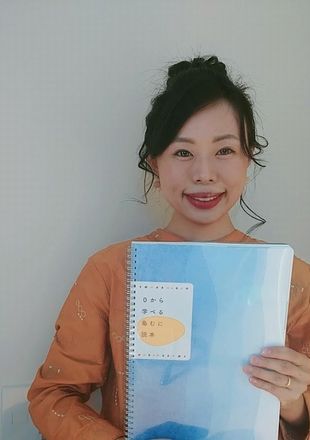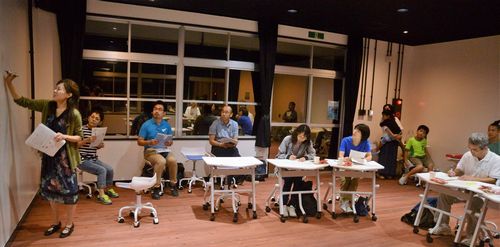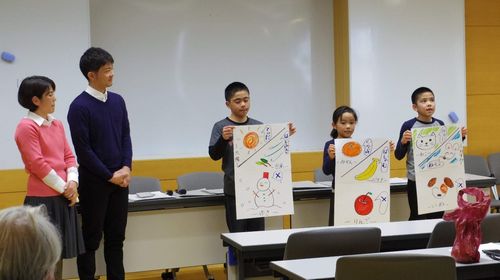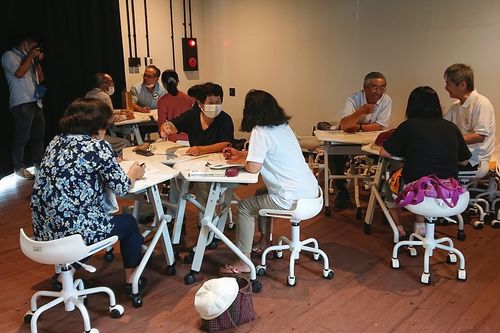Interview with Liberal Arts Communicator YOKOYAMA Akiko

Interview with Liberal Arts Communicator YOKOYAMA Akiko
(National Institute for Japanese Language and Linguistics)
Encountering Linguistics and Dialectology
In a university class “language and society”, there was a discussion on the geographical distribution of the dialects of aho and baka (both meaning “fool”) which was explored on the television program Tantei! Naito skūpu 'Knight Scoop'. The program aimed to discover the demarcation line between the use of baka, the word for “fool” in Kantō (eastern Japan) dialects and aho, which is more widespread in Kansai (western Japan) dialects. The program presented a dialect atlas of the word “fool” in Japan prepared by its researchers, which captured my interest.
The program also explored the practice of blowing off steam by yelling bakayarō! ‘stupid fool!’ in the regional language out to sea, with samples taken at the northernmost, easternmost, westernmost, and southernmost points of the country. On Miyakojima, at the southernmost extreme, the person shouted purimun at the top of their lungs. That is the word for ‘fool’ in the Miyako language, and I later discovered the word had its roots in the Edo period (1603–1868) word horemono ‘fool, stupid’.
I knew nothing about Ryukyuan languages when I watched the program, but I was struck at how “un-Japanese-like” the word purimun sounded and curious to know more about how such languages came from. When I told my seminar professor that I would like to go to Amami or Okinawa where the Ryukyuan languages are spoken, to which Miyako language belongs for research, she introduced me to an acquaintance of her on the island of Okinoerabu. I went knowing nothing about Okinoerabu, but that trip set me on the path of language research.
Features and Appeal of the Okinoerabu Northern Ryūkyū Languages
The languages not just of Okinoerabu but of the Ryūkyūs in general are said to be the only sister languages of Japanese. The languages shared common roots before branching off in different directions sometime before the seventh century; they further diverged among the various islands after that. Words in the Okinoerabu language like wugamiyabura ‘hello’ or mihedeirodō ‘thank you’ sound like a foreign language to Japanese. This language does not have a mutual intelligibility with Japanese, as university students in Tokyo can understand only 5 percent of the Okinoerabu language. But the languages share the same roots with Japanese; the correspondence of sounds occurs regularly and some words or grammar come from archaic Japanese. So, while they are seemingly different, there are some intriguing links between them.
I study the Okinoerabu language, called Shimamuni, within the framework of linguistics. Hearing the word “dialect,” one tends to think in terms of how it differs from standard Japanese, but looking at the Shimamuni in comparison with the other languages of the world, the languages of the Ryūkyūs have quite distinct characteristics. For example, in most languages, whether Japanese, English or any other, polar question (which is answered in yes or no) almost has the rising intonation at the end of sentence. In Shimamuni, though, a question ends with a falling intonation.
When I went to Okinoerabu for the first time, the local inhabitants spoke to me in Shimamuni, I assumed from the falling intonation that the speaker was making a strong statement but later realized that this falling intonation signaled that I was being asked a question. My misunderstanding arose due to this marked difference in intonation between standard Japanese, my mother tongue, and Shimamuni.
Linguistic study Brings a Community Together
I began my research by writing a descriptive grammar of Shimamuni, as taught to me by elderly interlocutors. At first, we were on a researcher-research collaborator footing, but as I proceeded in my research, I began receiving various requests: such as to speak about the characteristics of Shimamuni at local elementary schools and public halls on the island.
As a researcher, I initially hesitated to say that Shimamuni should be preserved, as I felt it was not my place as an outsider to tell the islanders what to do. But when I told them that their language was on the UNESCO endangered language list or that compared to other languages of the world it has distinct, unusual features, which are not found even in standard Japanese, they began showing interest. More and more local residents expressed a desire to learn to speak Shimamuni and came around to thinking that the language should be preserved. People want to be able to retain their language, and I, as someone who started off knowing no Shimamuni, learned the grammar, and acquired fluency, felt it was only natural to impart what I knew to them.

A Shimamuni class for adults. (2018)
At first, I was simply teaching, in the one-way communication style akin to a university lecture. Ultimately, it became clear that trying to pass on the language without some kind of spontaneous community involvement would be futile. Together with an associate professor Masahiro Yamada of the National Institute for Japanese Language and Linguistics (NINJAL), I launched a project at an Okinoerabu elementary school. As part of summer holiday homework, the children were asked to investigate Shimamuni along with their parents and grandparents, the results of which would be presented at NINJAL.
Things did not get off to a smooth start, but as time passed, the project attracted greater response than I had expected. The Maeda family, pictured below, carried on speaking Shimamuni at home even 4 years after their presentation at NINJAL. Looking back over this activity, I think it is important that researchers should not only communicate their knowledge to the local inhabitants, but also encourage local residents to step up voluntarily. My personal experience showed that the more they take the initiative, the more durable language preservation activities will become.

The MAEDA family’s presentation at the Yushikya Shimamuni Project. (National Institute for Japanese Language and Linguistics, 2019)
Since that time, public hall lectures held in the community, which help “create citizen scientists,” have provided opportunities for participants to record and report on Shimamuni by themselves and talk about their own activities. In addition, while in the past researchers often suggested projects they had planned to community members and worked with them, nowadays as the community is actively participating, there are more cases when local people come up with projects and we researchers respond in such a way as to meet their needs. It is clear that residents are now taking the initiative.

Shimamuni salon participants at the local public hall. (2020)
Why I Became a Liberal Arts Communicator
It seems to me that the activities of a liberal arts communicator are quite similar to what I have been doing so far. My activities have been based on research, but of course the information I have gotten from the research should be informed in the community, moreover, we should think about what is the best way to preserve language together with local residents. The job description of a liberal arts communicator includes feeding back knowledge gained from the community for research, and I fully embrace that idea.
While being interviewed for positions other than that of liberal arts communicator, interviewers tend to understand my activities in the community as a “social contribution” and comment as like “giving back to the community is all well and good, but what about research and teaching?” I was not consciously giving back to the community. Rather, it seemed to me only natural that, as far as studying an endangered language was concerned, there ought to be opportunities to give the community feedback on my findings. Moreover, it is impossible not to involve the community when speaking of revitalizing an endangered language. In general, people tend to think that community involvement lies outside the framework of research per se, but I believe that such involvement is a valuable element in the work of a liberal arts communicator. I applied to become a liberal arts communicator, so I believe that the work I have done so far is worthwhile and that I can carry on what I have been doing.
My Work at the National Institute for Japanese Language and Linguistics
As a member of the Endangered Languages Preservation Project at NINJAL, I provide support for recording languages / dialects in various parts of Japan, creating a database and supporting regional activities. I helped to document a local language on Okinoerabu, but Japan has countless regional dialects that differ from one village to the next, and many will have disappeared by the time researchers can study them. From the perspectives of both research and contributing to the community, it is better to increase the number of people in the community who can help record their local tongue. Having them share their discoveries endows them with something valuable and also contributes to their knowledge and experience. Lately, more and more people, not only on Okinoerabu but also in many other parts of the country, have been assuming responsibility for recording their language. This gives researchers more opportunities to support them and make their data public.
As a member of the NINJAL public relations office, I also handle public relations work. The NINJAL website includes a section called “Questions about Words,” where researchers answer questions from the general public about things they have always wondered about concerning language, and my first job was to pick up and consider their wonders. Incidentally, in 2021 NINJAL published a compilation of past questions and answers in a book called Nihongo no daigimon: nemurenakunaru hodo omoshiroi kotoba no sekai ‘Big Questions about the Japanese Language that Keep Us Awake at Night’.
Future Projects for Liberal Arts Communicators
Komai Sachi, who is affiliated with the International Research Center for Japanese Studies (Nichibunken), works with me as a liberal arts communicator, and from time to time, we discuss plans to conduct joint research with other liberal arts communicators. Although we all work in different research fields, we could use the same research methodology to work, so I would like to explore liberal arts communication more deeply, investigating how to establish an academic methodology for conducting research activities building on feedback from the society concerning research findings. Since I have become a liberal arts communicator myself, first I need to learn how to do so in my own field; otherwise, it would be impossible to adopt the methodology in other fields.
Another thing I have realized is that accepting requests from the community can help broaden my research. For example, there is a support program for technical trainees from Southeast Asian countries and foreign workers living on Okinoerabu who work in hotels and restaurants there. And on farms where many workers are non-Japanese, even today local people tend to communicate in local language rather than standard Japanese. The newcomers learn Japanese before starting to work in their jobs, but no dialect is taught. As a result, they do not understand what is being said, and the barriers to communication remain. Together with local residents working to facilitate integration into the community, I am helping to create a pamphlet for the foreign workers, who have requested inclusion of the Shimamuni terms used in daily interactions in its content.
I have also been asked to help in medical and nursing care settings. Among people in their 80s and older whose first language is Shimamuni, some forget standard Japanese and revert to Shimamuni. Others can communicate in standard Japanese but find it easier to express their innermost feelings in Shimamuni and may stop speaking if they are expected to use standard Japanese. Even if caregivers cannot speak in Shimamuni, understanding it can encourage the elderly people they are caring for to speak as they like. I have heard that workers just being able to speak a few words in Shimamuni is beneficial to care home residents, so I would like to lend my support for this aspect of medical and nursing care.
I have received many more requests from community members than I had expected, which has helped broaden the scope of my research. I am looking forward to more such interactions and making further progress in research.
(Interviewer: OHBA Go, Researcher, Center for Innovative Research, National Institutes for the Humanities)
YOKOYAMA Akiko
Specially Appointed Assistant Professor, National Institute for Japanese Language and Linguistics
Has been describing the language description, documentation and revitalization of Okinoerabu language spoken in Okinoerabu, one of the islands in the Amami archipelago, since 2010. Author of books including Zero kara manaberu Shimamuni dokuhon ‘Shimamuni for Beginners: A Reader’, Shio isshō no un ‘The Destiny of One Shō of Salt’, and Shimanotope ‘The Onomatopeia of Shimamuni’.
Social media: X (formerly twitter)
@akikomuni (personal account),
@erabumuni (Shimamuni)

